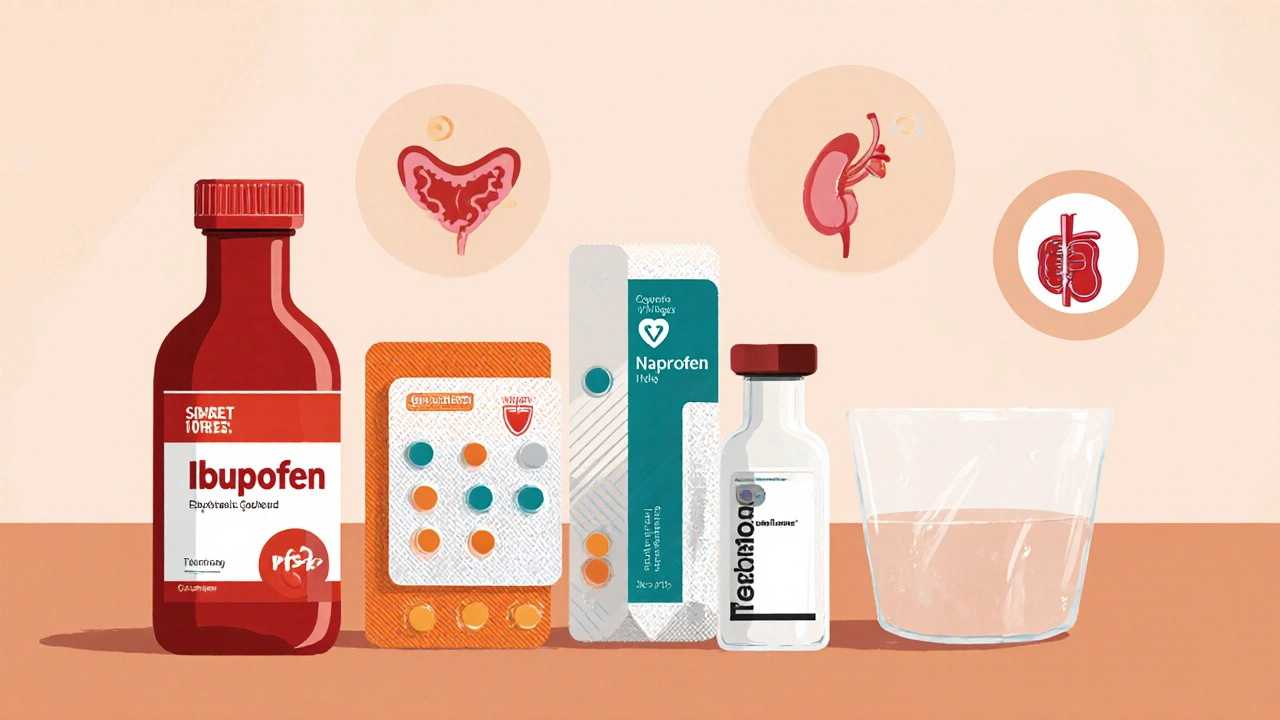Pain Relief Medication Selector
This tool helps you determine which pain relief option is most appropriate for your situation based on the information in the article. It considers pain intensity, health conditions, and treatment duration to provide personalized recommendations.
When you need fast, strong pain relief after surgery or a severe injury, the name Toradol often pops up. But is it the right choice for you, or are there safer, cheaper options that work just as well? This guide breaks down how ketorolac compares to the most common alternatives, so you can decide what fits your health needs and budget.
What is Toradol (Ketorolac) and how does it work?
Toradol is a brand name for ketorolac, a potent non‑steroidal anti‑inflammatory drug (NSAID) that blocks cyclooxygenase (COX) enzymes. By inhibiting COX‑1 and COX‑2, it reduces prostaglandin production, which in turn dampens inflammation and blunts the pain signals sent to the brain. Unlike many over‑the‑counter NSAIDs, ketorolac is strong enough to be classified between a regular NSAID and an opioid in terms of pain‑relieving power.
When is Toradol typically prescribed?
- Post‑operative pain after major surgery (orthopedic, abdominal, dental extractions).
- Severe musculoskeletal injuries where rapid pain control is critical.
- Situations where a short, powerful analgesic is preferred over longer‑acting opioids.
Because its analgesic effect peaks within 30‑60 minutes and lasts up to 6 hours, doctors often give it as a single dose or a brief 5‑day course. This short‑term use is the key safety guideline - ketorolac is **not** meant for chronic pain.

Key safety concerns and contraindications
Ketorolac carries a higher risk profile than many OTC NSAIDs. The main warnings include:
- Gastrointestinal bleeding: COX‑1 inhibition reduces the stomach’s protective mucus, raising ulcer risk.
- Kidney injury: Reduced renal prostaglandins can impair blood flow, especially in dehydration or existing renal disease.
- Cardiovascular events: Like other NSAIDs, it may increase heart attack or stroke risk, particularly in patients with existing heart disease.
- Contraindicated in pregnancy after 30 weeks, in patients with active peptic ulcer disease, and in anyone taking anticoagulants without close monitoring.
Because of these risks, many clinicians limit the total dose to no more than 40mg per day and never exceed a 5‑day treatment window.
Common alternatives to Toradol
Below are the most frequently used analgesics that can serve as substitutes, each with its own risk‑benefit balance.
- Ibuprofen - an OTC NSAID (200‑800mg every 6‑8h) that offers moderate pain control with a lower risk of renal toxicity than ketorolac when used short‑term.
- Naproxen - longer‑acting NSAID (250‑500mg twice daily) suitable for musculoskeletal pain, but still carries GI‑bleed risk.
- Celecoxib - a selective COX‑2 inhibitor that reduces GI side effects but can raise cardiovascular risk; often prescribed for arthritis.
- Acetaminophen - non‑NSAID analgesic (up to 3g/day) ideal for patients who can’t tolerate NSAIDs, but lacks anti‑inflammatory action.
- Diclofenac - a potent NSAID available in oral and topical forms; effective for joint pain but can be harsh on the stomach.
Side‑by‑side comparison
| Attribute | Toradol (ketorolac) | Ibuprofen | Naproxen | Celecoxib | Acetaminophen |
|---|---|---|---|---|---|
| Drug class | Non‑selective NSAID | Non‑selective NSAID | Non‑selective NSAID | COX‑2 selective NSAID | Analgesic/antipyretic (non‑NSAID) |
| Typical dose (adult) | 10‑30mg IV/IM/PO every 6h (max 40mg/day) | 200‑800mg PO every 6‑8h | 250‑500mg PO twice daily | 100‑200mg PO twice daily | 500‑1000mg PO every 6h (max 3g) |
| Onset of action | 30‑60min | 30‑60min | 45‑60min | 1‑2h | 30‑60min |
| Duration of effect | 4‑6h | 4‑6h | 8‑12h | 12‑24h | 4‑6h |
| GI bleed risk | High (especially >5days) | Moderate | Moderate | Low (COX‑2 selective) | Very low |
| Kidney risk | Significant (esp. dehydration) | Low‑moderate | Low‑moderate | Low‑moderate | Low |
| Cardiovascular risk | Elevated (short‑term) | Low‑moderate | Low‑moderate | Higher (COX‑2) | Low |
| Typical use case | Short‑term acute pain (post‑op, trauma) | Mild‑moderate pain, fever | Musculoskeletal pain, arthritis | Arthritis, chronic inflammatory pain | Fever, mild pain, patients unable to take NSAIDs |
| Prescription status | Prescription‑only (injectable & oral) | OTC | OTC (higher doses prescription) | Prescription (OTC 200mg in some countries) | OTC |

How to choose the right pain reliever
Consider these three questions before you settle on a medication:
- How intense is the pain? For severe, breakthrough pain after surgery, ketorolac’s potency can be life‑changing. For mild‑to‑moderate aches, an OTC NSAID or acetaminophen is often sufficient.
- What health conditions do you have? If you have a history of ulcers, kidney disease, or are on blood thinners, avoid ketorolac and perhaps even non‑selective NSAIDs. Celecoxib may be safer for the stomach but watch the heart.
- How long will you need the drug? Ketorolac must be limited to ≤5days. For longer courses, switch to ibuprofen, naproxen, or a COX‑2 inhibitor, or rotate with acetaminophen to lower total NSAID exposure.
In many cases, clinicians use a “step‑down” approach: start with a short ketorolac infusion for immediate relief, then transition to oral ibuprofen or acetaminophen as the pain eases.
Practical dosing and monitoring tips
- Always confirm renal function (creatinine clearance) before giving ketorolac. If CrCl<30mL/min, choose an alternative.
- Ensure the patient is well‑hydrated; dehydration dramatically raises the risk of kidney injury.
- Co‑prescribe a proton‑pump inhibitor (e.g., omeprazole) if the patient needs a prolonged NSAID course, especially with ibuprofen or naproxen.
- Monitor for signs of GI bleeding (black stools, abdominal pain) and for sudden drops in blood pressure, which may indicate renal compromise.
- Educate patients that exceeding the 5‑day limit for ketorolac can lead to severe side effects. Set a clear stop date.
Frequently Asked Questions
Can I take ibuprofen after a course of Toradol?
Yes. Switching to ibuprofen once the ketorolac course ends is a common step‑down strategy. Keep the ibuprofen dose within recommended limits and watch for stomach issues.
Why is Toradol limited to 5 days?
Ketorolac’s strong COX inhibition sharply raises the risk of gastrointestinal bleeding and kidney damage when used longer. Studies show complications rise dramatically after the fifth day, so guidelines cap it at five.
Is Celecoxib safer for my heart?
Unfortunately, celecoxib, as a COX‑2 selective NSAID, can increase cardiovascular risk, especially at higher doses. If you have heart disease, discuss alternatives like low‑dose acetaminophen or a carefully monitored NSAID regimen with your doctor.
Can pregnant women use Toradol?
Ketorolac is contraindicated after 30weeks of pregnancy because it can cause premature closure of the fetal ductus arteriosus. Safer options for pregnant patients include acetaminophen under medical guidance.
What over‑the‑counter option is closest in strength to Toradol?
No OTC drug matches ketorolac’s potency. The closest are high‑dose ibuprofen (800mg) or naproxen (500mg), but they still fall short for severe post‑operative pain.


